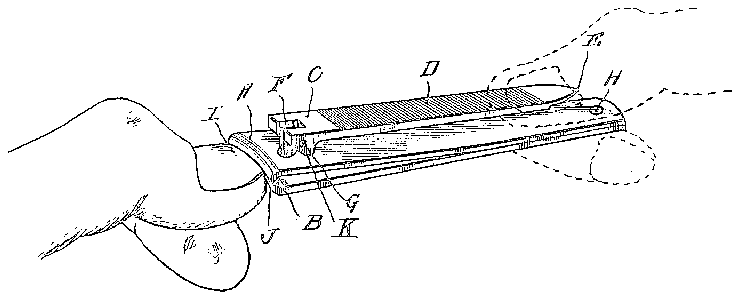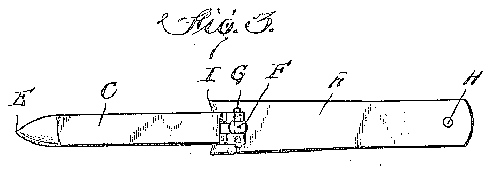

- 3 lfigure
- 229pmtmgqi aug
Description
man wmsnnae, orA new vean, n. r.
i ECRIRE T.
naaaeee,
Specification of Letters Patent. Pmtmgqi Aug 229 )19220 application tiled February l, 1922. -Serial No. 533,%4.
To all lwhom 'it may concern.' Be it known that l, NAT WIESENBERG, a
citizen of the United States, and a resident- Aand improved implement for cutting the nails and is provided with a nail file and nail cleaner for the purpose of performing operations on the nails, and has for its object to provide an extremely handy device. lhe tool being simple and durable in construction and adapted to told in a comparatively small space for pocket use. rlChe invention consists of novel eatures and parts and combinations of the same as will be fully described hereinafter andthen pointed out in the claim.
A practical embodiment of the invention is represented in the accompanying drawings forming a part of the specication in which similar characters ot' reference indicate corresponding parts in all the views.,
Figure l is al perspective view of iinprovement being operated, lever manipulated so that a finger nail inserted between cutting edges is cut eilt Figure 2 is a side elevation of the same in a folded position.
lFigure 3 is a plan view of the same.
The implement comprises two similar resilient members, A and B. rlhese members have linger nail cutters, l and d, at one end and are secured or maintained at their other ends in superposed liged relations by any suitable means, as a rivet lil. t some considerable distance from the rivet, ll, the members, A and B,-diverge from a line, L, to a position near the cutters which' are oppositely disposed to extend toward each other. Eacho the `members are provided .adjacent the cutters withv aligned circular apertures, which are adapted to receive `a bolt, F, which/has a head at one end adapted to engage swivelly the outer surface oil' one member while the other end is aper- :tured to receive a pivot pin, G. 'lhe bolt is reduced or atjtened on opposite sides to produce plane surfaces which are vadapted to engage the adjacent parallel surfaces of the lever on opposite sides ont the recess. The lever C is apertured transversely of the recess to secure the lever pivotally to the bolt F by means of the pin Gr.
The surface opposite the cams or'l the leI ver@ is roughened to produce a naille D, while the tree end of the lever terminates 1n a linger nail cleaner E. The' bolt F has a guard portion M, which extends upwardly beyond the end of the lever and a ort1on of the cams when the device is to ded so that the material, forming the garment or outer pocket, may not be drawn so sharply over the corners of the lever and the edges of the cams K, thereby preventing needless wear of the container or pocket in which the implement is carried.
The device is normally maintained in the condition shown in Fig. 2. To use the nail le D, or cleaner E, the lever C is moved sidewlise to swivel the 4bolt F and thereby bring the die D into a plane substantially' parallel with the member ment with said memben To bring the cutters l and @l into opera,- tion the lever is moved 'to rotate the bolt and then moved about the pivot G to bring the cam elements l into contact with the members A and then by a downward movement of the lever the members A and B are i'orced toward each other against the resilience of said members.,v while the appreaching cutters most effectively sever a A, or 1n alignlinger nail which is placed in position be-v tween the cutters.
ear-enr @wing to the extended bearing or concontact between the flattened' surfaces of the bolt and the side walls of the recess while relieving to some extent the. strain upon thepin G, is to prevent undue swear of 'the co-Operating parts and consequently,
maintains the parts in the required relation,
even after a most extended use of the device.
Equivalent variations may be resorted to within the scope of the subject matter claimed.
What l claim is:
A' nail cutter comprising two similar resilient members superimposed and united iixedly at one end 5 minor portions of said memberslying in contact with'each other; major portions of said members being di-v lll@ Q meme@ vergently arrfmge and having oppositely length and thickness to serve es it guard disposed cutters on their free ends extendfor the corners and cam elements on the biing toward each other; each of said memfurcated end of said lever. bers being apertured adjacent their free In testimony whereof I have hereunto set 5 ends, a swivel ot in lseid aperture ;tt1he ilpmy hand in the presence of two witnesses. 15
)er end of sai ot :wing opposi e y `s T x -l v iposed Het surfaces. and being transversely RAE WESENBERG' A epertured whereby it may be pivotally se- Witnesses: cured in the bifurcated end of an operating EMZABETH G.4 BIGHAM,
110 cam lever. The bolt being of sufficient MARY (l. WHEATLEY;
